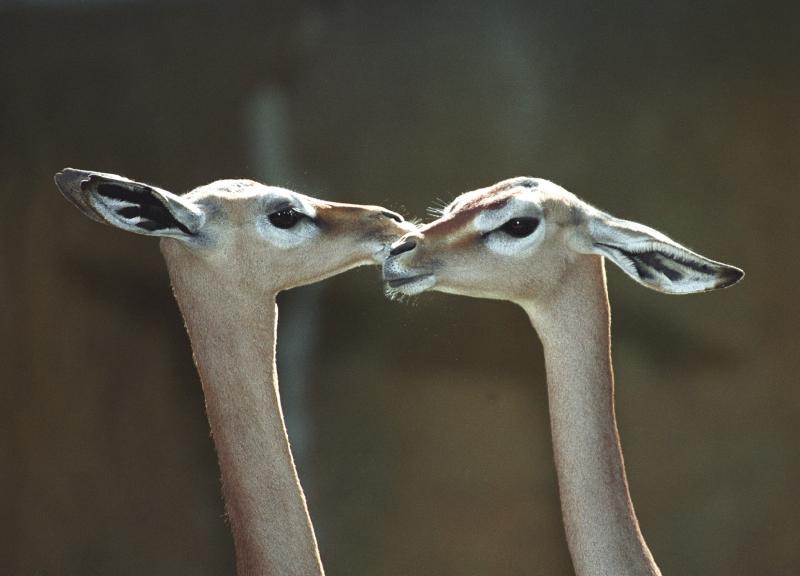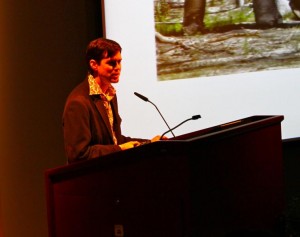Bedroom Talk at the L.A. Zoo

For those that were looking for a unique way to spend their Valentine’s Day weekend, a trip to the L.A. Zoo might have been the perfect choice.
The Greater Los Angeles Zoo Association hosted “Sex and the City Zoo 2” on Sunday, a fundraiser intended to help fund the zoo. The lighthearted lecture taught people about the mating, dating and cohabiting behaviors of animals in the wild. Sponsors of the event also provided couples with free champagne, wine and dessert to enjoy prior to the lecture.
intended to help fund the zoo. The lighthearted lecture taught people about the mating, dating and cohabiting behaviors of animals in the wild. Sponsors of the event also provided couples with free champagne, wine and dessert to enjoy prior to the lecture.
While learning about animals may not sound romantic, host Jason Jacobs, the zoo’s director of public relations and marketing, was able to relate animal behaviors to the mating styles of humans in a comedic and entertaining fashion.
Jacobs provided the audience with a slide show presentation of the animals he discussed, often showing mating tigers or an elephant will extremely large sexual
organs. He discussed the wild, weird and interesting things animals do when they are mating. For example, Jacobs mentioned that flamingos would only mate when there are multiple partners available. He said they are similar to humans who enjoy swinging.
Sometimes Jacobs would even use animal behavior as a way of giving advice. When talking about emus, Jacobs mentioned that the females will go after the males when they are ready to mate. The female will mate with the male and then he is in charge of taking care of the eggs.
Jacobs’ advice after introducing the emu was, “females, sometimes you should take the initiative.”
 At the end of his hour-long presentation, Jacobs quizzed the audience about their own mating style. The quiz was called, “What Type of Lover Are You,” it was a scientific take on the type of quiz you’d see in Cosmopolitan magazine. One of the questions he asked in the quiz was, “How would you describe the sounds you make during sex?” Jacobs asked the audience five questions before giving them their results. Audience members were either a gorilla, chimpanzee, orangutan or a gibbon. The majority of the audience was a gibbon. Jacobs said he expected the results because gibbons are most similar to humans when it comes to mating. They prefer to remain in monogamous relationships and only have children with a single partner.
At the end of his hour-long presentation, Jacobs quizzed the audience about their own mating style. The quiz was called, “What Type of Lover Are You,” it was a scientific take on the type of quiz you’d see in Cosmopolitan magazine. One of the questions he asked in the quiz was, “How would you describe the sounds you make during sex?” Jacobs asked the audience five questions before giving them their results. Audience members were either a gorilla, chimpanzee, orangutan or a gibbon. The majority of the audience was a gibbon. Jacobs said he expected the results because gibbons are most similar to humans when it comes to mating. They prefer to remain in monogamous relationships and only have children with a single partner.
Overall, the audience seemed to enjoy the evening. There were plenty of laughs and it was an interesting alternative to the typical Valentine’s Day dinner. It was also fairly priced. Members of GLAZA paid only $25 for unlimited dessert, wine, and the lecture. The general admission price was $35 per person. This was the L.A. Zoo’s second year putting on this event and they will likely continue the tradition.
Below is an interview with Jason Jacobs from the event. It was his first year giving the lecture.
How did you end up getting this gig?
One of the staff members asked if I would do it because they knew I’d given a talk similar to this in the past and I said sure and put the talk together and it was quite fun to educate people about animals. It’s a fun subject but it’s actually, a lot of reason animals have their mating behavior there’s biological reasons behind it. Reproduction and survival of the fittest
How were you able to make it funny and relate it back to human behavior?
I think that a lot of times people look at animals and they anthropomorphize about them, they give human emotions and feelings to animals when they’re really not there. So when you look at something like the mating behaviors of deer, you know it’s not too different from humans but it’s some stuff that’s very funny if you think about it in terms of what we do. We’re not going to roll around in the mud and urinate on ourselves to get musty like a deer does.
When you were giving the speech were there a lot of animals that you maybe left out?
You know I really wanted to cover what I would consider the charismatic mega vertebrates, animals that people know about, like elephants, and rhinos, and lions and tigers. I think it’s much easier to relate information about the animals that you already know about. But I did bring in some lesser-known species such as the cock-of-the-rock.
What’s one animal that you didn’t cover that you think is really interesting?
I didn’t cover marsupials and marsupials have a really unique reproductive strategy because they give birth to young that’s almost in embryonic form that lives in a pouch for the first six months of its life. So if you can imagine, if you relate that to a human, imagine your youngster being born and then you have to carry it around. Humans don’t do that though, but you know I thought marsupials… I probably could’ve gone into a little bit about them.
How did you feel about giving this presentation for the first time?
I was a little nervous, but you know everyone seemed to really enjoy themselves and they were laughing and I think they came away knowing a little something more about animals, which was a great thing. We had a lot of gibbons in the room.
How long did it take you prepare this whole thing?
It took a couple of days because a lot of this is stuff that I’ve acquired through the years of working. You know when you’ve worked in zoos for twenty years you study up on animals that come into the collection or animals that you’ve worked with. Although I don’t work with the animals anymore, you know it’s a one track mind for me I enjoy going to zoos and studying and learning about animals and it never ends, there’s always something new you can learn about.
In your introduction I heard that you started doing this when you were 13, how did you actually get into this kind of work?
I’ve always wanted to work in zoos every since I was a kid. I started volunteering at the Miami Zoo when I was 13; they hired me when I was 17. I went to school for ecology and I’ve just worked nonstop in the industry for over 20 years now and I love it. I don’t know what I would do if I didn’t work in a zoo.
Is there anything you’d like to add?
Well you know the Los Angeles Zoo is a great place to go. You can see mating behavior but you can see a lot of other behavior with our fantastic animal collection. It’s just north of downtown and you can see animals from all corners of the globe and really some great stuff so come on out to the zoo.
